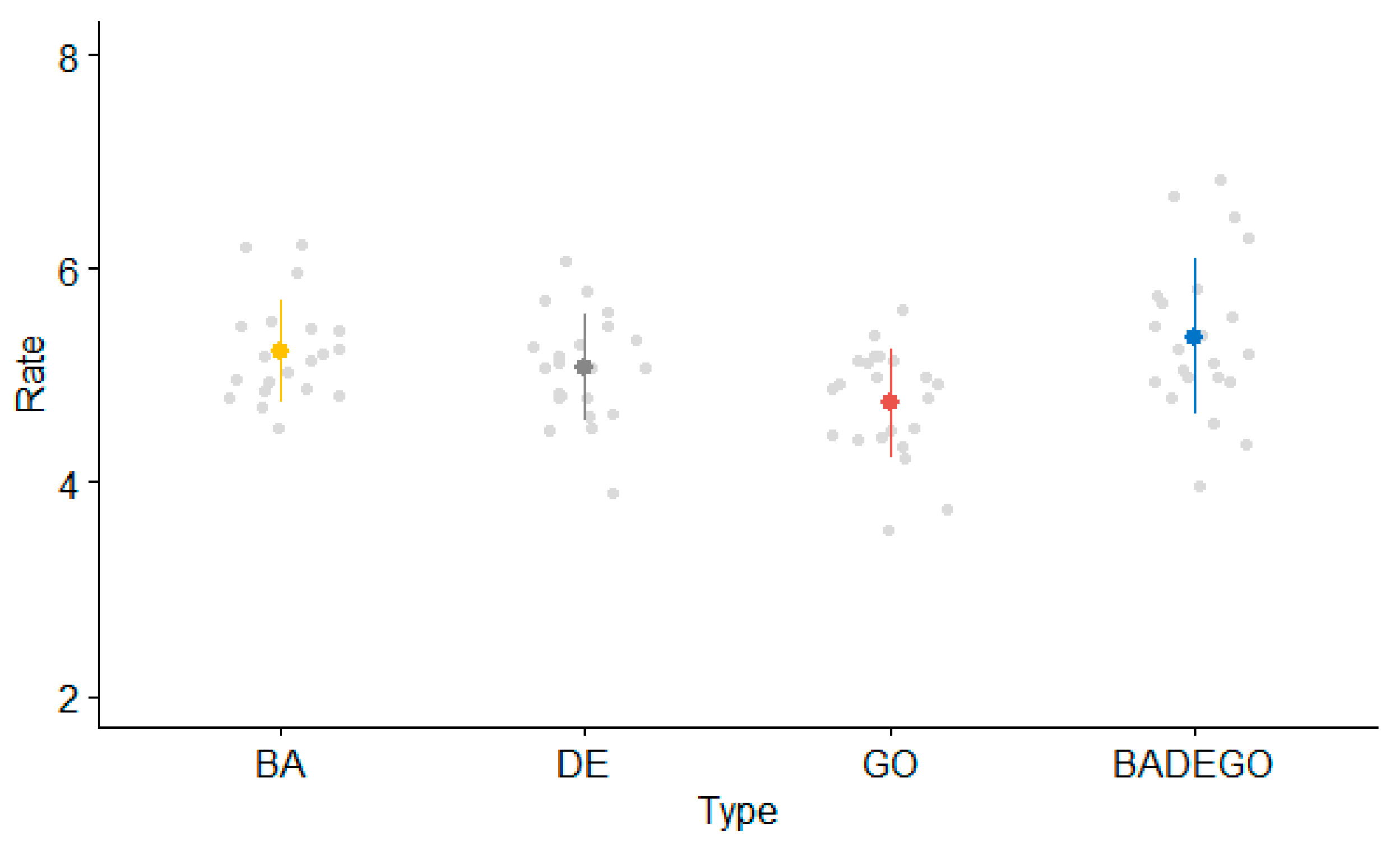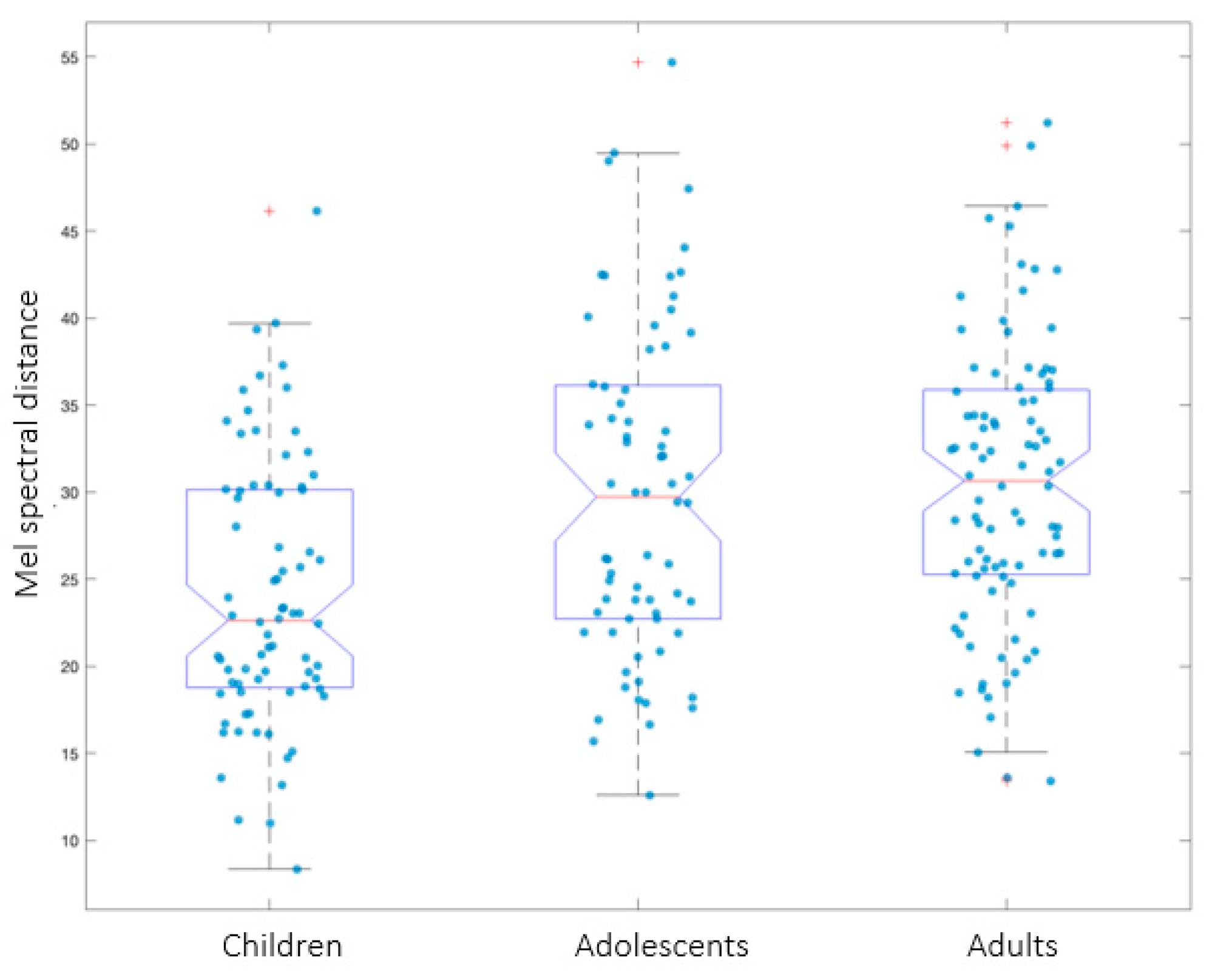What Do Differences between Alternating and Sequential Diadochokinetic Tasks Tell Us about the Development of Oromotor Skills? An Insight from Childhood to Adulthood
Abstract
1. Introduction
2. Materials and Methods
2.1. Participants
2.2. Material
2.3. Procedure
2.4. Syllabic Rate Analysis
2.5. Acoustic Analyses
2.5.1. Prosodic Features
2.5.2. Anticipatory Coarticulation
3. Results
3.1. Syllabic Rate
Additional Syllabic Rate Analysis
- Adolescents
- Adults
3.2. Acoustic Analyses
Prosodic Features
- Fundamental frequency (fo)
- Intensity
3.3. Anticipatory Coarticulation
4. Discussion
5. Conclusions
Supplementary Materials
Author Contributions
Funding
Institutional Review Board Statement
Informed Consent Statement
Data Availability Statement
Conflicts of Interest
References
- Duffy, J.R. Motor Speech Disorders: Substrates, Differential Diagnosis, and Management; Mosby: St. Louis, MI, USA, 2005. [Google Scholar]
- Hurkmans, J.; Jonkers, R.; Boonstra, A.M.; Stewart, R.E.; Reinders-Messelink, H.A. Assessing the treatment effects in apraxia of speech: Introduction and evaluation of the Modified Diadochokinesis Test. Int. J. Lang. Commun. Disord. 2012, 47, 427–436. [Google Scholar] [CrossRef] [PubMed]
- Prathanee, B. Oral diadochokinetic rate in adults. J. Med. Assoc. Thail. Chotmaihet Thangphaet 1998, 81, 784–788. [Google Scholar]
- Canning, B.; Rose, M. Clinical measurements of the speed of tongue and lip movements in British children with normal speech. Br. J. Disord. Commun. 1974, 9, 45–50. [Google Scholar] [CrossRef] [PubMed]
- Jang, J.; Choe, Y.G.; Ha, S. Characteristics of diadochokinesis in typically developing children and adults. Audiol. Speech Res. 2020, 17, 73–80. [Google Scholar] [CrossRef]
- Jeng, J.Y. Changes in indicator values of speech function across lifespan. Bull. Educ. Psychol. 2022, 51, 613–637. [Google Scholar]
- Prathanee, B.; Thanaviratananich, S.; Pongjanyakul, A. Oral diadochokinetic rates for normal Thai children. Int. J. Lang. Commun. Disord. 2003, 38, 417–428. [Google Scholar] [CrossRef]
- van Haaften, L.; Diepeveen, S.; Terband, H.; De Swart, B.; Van Den Engel-Hoek, L.; Maassen, B. Maximum repetition rate in a large cross-sectional sample of typically developing Dutch-speaking children. Int. J. Speech-Lang. Pathol. 2021, 23, 508–518. [Google Scholar] [CrossRef]
- Fletcher, S.G. Time-by-count measurement of diadochokinetic syllable rate. J. Speech Hear. Res. 1972, 15, 763–770. [Google Scholar] [CrossRef]
- Jeng, J.Y. The vocal phonation and oral diadochokinetic movement in the elderly. J. Med. Health 2020, 9, 41–51. [Google Scholar]
- Jothi, S.; Amritha, M. Comparison of diadochokinetic rate between Malayalam and Tamil native speakers. Int. J. Res. Rev. 2019, 6, 144–148. [Google Scholar]
- Knuijt, S.; Kalf, J.G.; van Engelen, B.G.; de Swart, B.J.; Geurts, A.C. The Radboud dysarthria assessment: Development and clinimetric evaluation. Folia Phoniatr. Logop. 2017, 69, 143–153. [Google Scholar] [CrossRef]
- Mousavi, S.Z.; Mehri, A.; Nabavi, D.; Faraji, M.; Maroufizadeh, S. Comparing the diadochokinetic rate in Farsi-speaking young and older adults. Iran. Rehabil. J. 2020, 18, 57–64. [Google Scholar] [CrossRef]
- Neel, A.T.; Palmer, P.M. Is tongue strength an important influence on rate of articulation in diadochokinetic and reading tasks? J. Speech Lang. Hear. Res. 2012, 55, 235–246. [Google Scholar] [CrossRef] [PubMed]
- Padovani, M.; Gielow, I.; Behlau, M. Phonarticulatory diadochokinesis in young and elderly individuals. Arq. Neuro-Psiquiatr. 2009, 67, 58–61. [Google Scholar] [CrossRef]
- Pierce, J.E.; Cotton, S.; Perry, A. Alternating and sequential motion rates in older adults. Int. J. Lang. Commun. Disord. 2013, 48, 257–264. [Google Scholar] [CrossRef] [PubMed]
- Lass, N.J.; Sandusky, J.C. A study of the relationship of diadochokinetig rate, speaking rate and reading rate. Commun. Q. 1971, 19, 49–54. [Google Scholar] [CrossRef]
- Shin, M.-J.; Kim, J.-O.; Lee, S.-B.; Lee, S.-Y. A preliminary study of developing Korean Oro-motor Mechanism Screening Examination (KOMSE) in normal adults. Speech Sci. 2008, 15, 171–188. [Google Scholar]
- Ziegler, W.; Schölderle, T.; Brendel, B.; Amsellem, J.; Staiger, A. Higher-Faster-Farther: Maximum Performance Tests in the Assessment of Neurogenic Speech Impairment. Folia Phoniatr. Logop. 2019, 71, 261–274. [Google Scholar] [CrossRef]
- Bohland, J.W.; Bullock, D.; Guenther, F.H. Neural representations and mechanisms for the performance of simple speech sequences. J. Cogn. Neurosci. 2010, 22, 1504–1529. [Google Scholar] [CrossRef]
- Cheng, H.Y.; Murdoch, B.E.; Goozée, J.V. Temporal features of articulation from childhood to adolescence: An electropalatographic investigation. Clin. Linguist. Phon. 2007, 21, 481–499. [Google Scholar] [CrossRef]
- Namasivayam, A.K.; Coleman, D.; O’Dwyer, A.; Van Lieshout, P. Speech sound disorders in children: An articulatory phonology perspective. Front. Psychol. 2020, 10, 2998. [Google Scholar] [CrossRef] [PubMed]
- Smith, A.; Goffman, L. Stability and patterning of speech movement sequences in children and adults. J. Speech Lang. Hear. Res. 1998, 41, 18–30. [Google Scholar] [CrossRef]
- Smith, A.; Zelaznik, H.N. Development of functional synergies for speech motor coordination in childhood and adolescence. Dev. Psychobiol. 2004, 45, 22–33. [Google Scholar] [CrossRef] [PubMed]
- Irwin, J.V.; Becklund, O. Norms for maximum repetitive rates for certain sounds established with the sylrater. J. Speech Hear. Disord. 1953, 18, 149–160. [Google Scholar] [CrossRef] [PubMed]
- Jeong, H.-J.; Lee, O.-B.; Sehr, K.-H. Diadochokinetic skills in typically developing children aged 4–6 years: Pilot study. J. Korea Acad.-Ind. Coop. Soc. 2011, 12, 3149–3155. [Google Scholar]
- Nip, I.S.; Green, J.R. Increases in cognitive and linguistic processing primarily account for increases in speaking rate with age. Child Dev. 2013, 84, 1324–1337. [Google Scholar] [CrossRef]
- Hara, S.; Miura, H.; Yamasaki, K. Oral diadochokinesis among Japanese aged over 55 years: Analysis of standard values. Nihon Ronen Igakkai Zasshi. Jpn. J. Geriatr. 2013, 50, 258–263. [Google Scholar] [CrossRef]
- Kianfar, F.; Karimian, F.; Baktashian, M. Alternating and sequential motion rates for normal Persian-speaking people aged 60-80 years in Isfahan City, Iran. J. Res. Rehabil. Sci. 2017, 13, 125–130. [Google Scholar]
- Kugimiya, Y.; Oki, T.; Ohta, M.; Ryu, M.; Kobayashi, K.; Sakurai, K.; Ueda, T. Distribution of lip-seal strength and its relation to oral motor functions. Clin. Exp. Dent. Res. 2021, 7, 1122–1130. [Google Scholar] [CrossRef]
- Modolo, D.J.; Berretin-Felix, G.; Genaro, K.F.; Brasolotto, A.G. Oral and vocal fold diadochokinesis in children. Folia Phoniatr. Logop. 2011, 63, 1–8. [Google Scholar] [CrossRef]
- Kent, R.D.; Kim, Y.; Chen, L.-m. Oral and Laryngeal Diadochokinesis across the Life Span: A Scoping Review of Methods, Reference Data, and Clinical Applications. J. Speech Lang. Hear. Res. 2022, 65, 574–623. [Google Scholar] [CrossRef] [PubMed]
- Blomquist, B.L. Diadochokinetic movements of nine-, ten-, and eleven-year-old children. J. Speech Hear. Disord. 1950, 15, 159–164. [Google Scholar] [CrossRef] [PubMed]
- Choe, J.; Han, J.S. Diadochokinetic rate of normal children and adults: A preliminary study. Commun. Sci. Disord. 1998, 3, 183–194. [Google Scholar]
- Ptacek, P.H.; Sander, E.K.; Maloney, W.H.; Jackson, C.R. Phonatory and related changes with advanced age. J. Speech Hear. Res. 1966, 9, 353–360. [Google Scholar] [CrossRef]
- Wong, A.; Allegro, J.; Tirado, Y.; Chadha, N.; Campisi, P. Objective measurement of motor speech characteristics in the healthy pediatric population. Int. J. Pediatr. Otorhinolaryngol. 2011, 75, 1604–1611. [Google Scholar] [CrossRef]
- Deger, K.; Ziegler, W. Speech motor programming in apraxia of speech. J. Phon. 2002, 30, 321–335. [Google Scholar] [CrossRef]
- Fougeron, C.; Delvaux, V.; Ménard, L.; Laganaro, M. The MonPaGe_HA database for the documentation of spoken french throughout adulthood. In Proceedings of the Eleventh International Conference on Language Resources and Evaluation (LREC 2018), Miyazaki, Japan, 7–12 May 2018. [Google Scholar]
- Laganaro, M.; Fougeron, C.; Pernon, M.; Levêque, N.; Borel, S.; Fournet, M.; Chiuvé, S.C.; Lopez, U.; Trouville, R.; Ménard, L.; et al. Sensitivity and specificity of an acoustic- and perceptual-based tool for assessing motor speech disorders in French: The MonPaGe-screening protocol. Clin. Linguist. Phon. 2021, 35, 1060–1075. [Google Scholar] [CrossRef] [PubMed]
- New, B.; Brysbaert, M.; Veronis, J.; Pallier, C. The use of film subtitles to estimate word frequencies. Appl. Psycholinguist. 2007, 28, 661–677. [Google Scholar] [CrossRef]
- New, B.; Pallier, C.; Brysbaert, M.; Ferrand, L. Lexique 2: A new French lexical database. Behav. Res. Methods Instrum. Comput. 2004, 36, 516–524. [Google Scholar] [CrossRef]
- Boersma, P. Praat, a system for doing phonetics by computer. Glot. Int. 2001, 5, 341–345. [Google Scholar]
- Baayen, R.H.; Davidson, D.J.; Bates, D.M. Mixed-effects modeling with crossed random effects for subjects and items. J. Mem. Lang. 2008, 59, 390–412. [Google Scholar] [CrossRef]
- Xu, Y. ProsodyPro—A Tool for Large-scale Systematic Prosody Analysis. In Proceedings of the Tools and Resources for the Analysis of Speech Prosody (TRASP 2013), Aix-en-Provence, France, 30 August 2013; pp. 7–10. [Google Scholar]
- Vaissière, J. On French Prosody; Quaterly Progress Report; Research Laboratory of Electronics, Massachusetts Institute of Technology: Cambridge, MA, USA, 1974; Volume 114, pp. 212–223. [Google Scholar]
- Lenth, R.; Singmann, H.; Love, J.; Buerkner, P.; Herve, M. Emmeans: Estimated marginal means, aka least-squares means. R Package Version 2018, 1, 3. [Google Scholar]
- Staiger, A.; Schölderle, T.; Brendel, B.; Bötzel, K.; Ziegler, W. Oral motor abilities are task dependent: A factor analytic approach to performance rate. J. Mot. Behav. 2017, 49, 482–493. [Google Scholar] [CrossRef] [PubMed]
- Ergun, A.; Oder, W. Oral diadochokinesis and velocity of narrative speech: A prognostic parameter for the outcome of diffuse axonal injury in severe head trauma. Brain Inj. 2008, 22, 773–779. [Google Scholar] [CrossRef] [PubMed]
- Tjaden, K.; Watling, E. Characteristics of diadochokinesis in multiple sclerosis and Parkinson’s disease. Folia Phoniatr. Logop. 2003, 55, 241–259. [Google Scholar] [CrossRef]






| Mean Syllabic Rates (SD) | Difference SMR–AMR (%) | ||
|---|---|---|---|
| AMR | SMR | ||
| Children | 4.66 (0.64) | 4.85 (1.06) | 4% |
| Adolescents | 5.00 (0.53) | 5.37 (0.73) | 7% |
| Adults | 5.60 (0.88) | 6.41 (1.17) | 13% |
Disclaimer/Publisher’s Note: The statements, opinions and data contained in all publications are solely those of the individual author(s) and contributor(s) and not of MDPI and/or the editor(s). MDPI and/or the editor(s) disclaim responsibility for any injury to people or property resulting from any ideas, methods, instructions or products referred to in the content. |
© 2023 by the authors. Licensee MDPI, Basel, Switzerland. This article is an open access article distributed under the terms and conditions of the Creative Commons Attribution (CC BY) license (https://creativecommons.org/licenses/by/4.0/).
Share and Cite
Lancheros, M.; Friedrichs, D.; Laganaro, M. What Do Differences between Alternating and Sequential Diadochokinetic Tasks Tell Us about the Development of Oromotor Skills? An Insight from Childhood to Adulthood. Brain Sci. 2023, 13, 655. https://doi.org/10.3390/brainsci13040655
Lancheros M, Friedrichs D, Laganaro M. What Do Differences between Alternating and Sequential Diadochokinetic Tasks Tell Us about the Development of Oromotor Skills? An Insight from Childhood to Adulthood. Brain Sciences. 2023; 13(4):655. https://doi.org/10.3390/brainsci13040655
Chicago/Turabian StyleLancheros, Mónica, Daniel Friedrichs, and Marina Laganaro. 2023. "What Do Differences between Alternating and Sequential Diadochokinetic Tasks Tell Us about the Development of Oromotor Skills? An Insight from Childhood to Adulthood" Brain Sciences 13, no. 4: 655. https://doi.org/10.3390/brainsci13040655
APA StyleLancheros, M., Friedrichs, D., & Laganaro, M. (2023). What Do Differences between Alternating and Sequential Diadochokinetic Tasks Tell Us about the Development of Oromotor Skills? An Insight from Childhood to Adulthood. Brain Sciences, 13(4), 655. https://doi.org/10.3390/brainsci13040655







